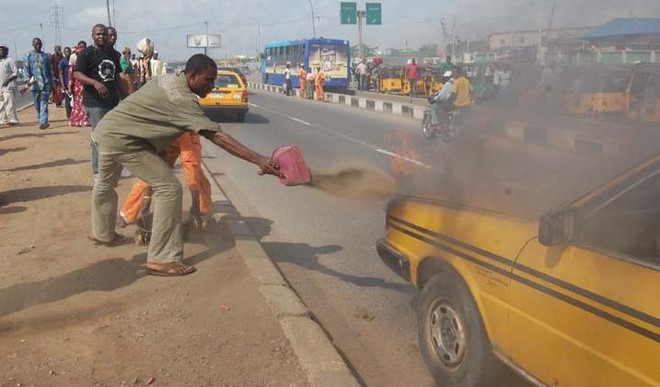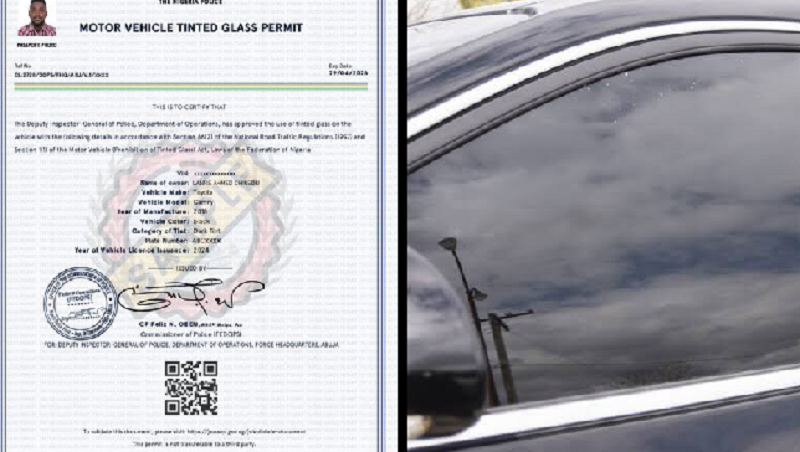Auto
Why Cars Catch Fire, How To Prevent Such


By Igono Joseph Okeme
INTRODUCTION
It is almost common to see vehicles going up in flames in Nigeria. It is really a helpless sight to behold. The occupants, if lucky, escape the raging infernos and some, who are not too really lucky, get killed as a result of various degrees of burns sustained in such incidents.
On one instance, when I was returning from one of the holy ghost services at the Redemption Camp early in the morning some months ago (I’m not by all means trying to be a religious PR here), I suddenly saw a Corolla ’08 in flames on the road. The owner of the car was nowhere to be found. Maybe he had gone to look for ‘water’ to fight the fire. Note of caution please; don’t use ordinary water to fight an inferno. That accelerates the fire because fuel is denser than water.
That day, before 8:00am, the car was totally burnt to ashes.
You could imagine environmental, economic, and psychological impacts that incident must have caused the owner, and the environment.
What would have happened, if other adjacent cars caught fire? Imagine the ripple effect of that for a minute.
Incidences like these occur in Lagos, especially areas where vehicles are at close proximity with each other.
WHAT CAUSES SUCH CASES?
For a fire to start, there must be the presence of AIR, FUEL, and a HEAT SOURCE.
There are lots of causes of car fire incidents.
The most common ones are:
- Fuel (petrol). Leaks along fuel lines pose a dangerous threat to safety here.
Cars with a leaky injector nozzle system seals can allow tiny droplets of fuel drop on hot spots on an engine, or exhaust system, thereby leading to a fire. These seals are usually weak, when they are exposed to tremendous heat from the engine, and the atmospheric temperature of the environment. Normally at 60,000miles, such seals lose their sealing properties, and create fire risks.
- Electrical issues. When you open up the hood of your car, you see bunch of wire harnesses, connectors, etc, acting as a conduit for the flow of current to various components of the car.
If any of these wiring harnesses has a SHORT CIRCUITS problem, the flow of current would be limited, at the load, leading to the current traveling to an undesignated route. This route could be the body of the car, which acts as a ground. This undesired current flow that has found a new path, could trigger a fire. If for instance there’s already a source of fuel provided it by a leaky fuel system component. Bu!!! you hear. Suddenly there’s a fire raging.
- Exhaust system. All internal combustion engine applications work through lots of friction and stress in order to produce the motion for the movement you and I enjoy when we drive our SUVs, or in a “danfo bus”. But have you ever thought that those applications could go through temperatures of up to 2000C? With this kind of extreme temperature, coupled with outside temperature, that might be in the range of 30-40C, what do you expect your engine to do? A clogged catalytic converter would generate even more extreme temperatures that could instantly lead to a fire. Even car owners look for an escape route when faced with the heat from traffic logjam on the road and work stress. You escape that by putting on your car’s AC system to take away that heat in exchange for a clean cool air. Isn’t it? OK. Same thing happens to your engine. This extreme temperature is exited through the exhaust system of the car, and straight to the environment.
Now, how does that exhaust system looks like?
Fuel system routed close to exhaust systems are at risks of causing car fires.
Manufacturers, over the years, have routed fuel lines away from exhaust systems, and even shielded the exhaust systems with shield materials to protect excess heat from setting off fires. Some fuel system lines also use heat shields, to help reduce the risks of fires.
- Oil spills. Engine oils and automatic transmission fluids spill on engine components like the transmission system, cylinder heads, exhaust system manifold, rotating driven solid shafts, and on engine chassis, etc can cause car fires.
The reason being as these spills gradually builds up into a sludge on those components, they trap dirt made of combustibles, making them susceptible to generating heat and smoke, and then results into a fire while driving.
HOW TO PREVENT CAR FIRES
The most effective way to prevent car fires are:
- Carry out preventive maintenance checks on all fuel, exhaust, and electrical systems at every oil change. These checks would help you determine their integrity, and eventually point out potential problem areas before they occur.
- Ensure all maintenance/repairs carried out on the car’s fire prone systems, such as the fuel, exhaust, and electrical systems are properly done.
Proper laid down procedures regarding repairs and safety must be strictly adhered to. Do not allow your mechanics to tell you, “Oga. It doesn’t matter to put on an exhaust heat shield, or let’s manage the fuel line clips. It won’t do anything”. If you currently have a mechanic like that as your mechanic, you have to run brother!
- Carry out steam washing of the engine bay monthly, or so. That would reduce the accumulation of oil spill build up on the engine area.
If you’re scared of allowing your engine to be steam washed, you could hand wash it.
***use solvents such as petrol, or diesel fuel, to help remove oil spills, and apply a soapy solution to wash the affected parts mildly.
NB: Ensure the cars ECU (commonly called brainbox), and ignition control modules are protected from water sprays because they could foul the system and cause you tremendous money fixing them.
WHAT DO YOU DO WHEN YOUR CAR CATCHES FIRE
Well, I know some of us are so religious when it comes to predictive maintenance and stuffs like that. But I think it is cool for you to have some tips on your hand just in case, perhaps, your neighbour’s car catches fire, this is what you should do.
- If you notice smoke billowing out of the car while driving, pull over off the road to a safe place and park.
Don’t open the hood because there’s the risk the fire could spread further because opening up the hood creates more oxygen intake for the car and that accelerates the fire.
- Get out of the car as soon as possible If you can.
Do not attempt to return back to the car to rescue your laptop, galaxy note 7, and even your jewellery. I think it is better you’re alive than die in that fire; doesn’t make sense to me though. But maybe that’s not my business.
- Disconnect the power source if you can. Some cars like Benz, BMW, Renaults don’t have their batteries located at the front. They’re at the rear or at the front passenger seat. Be bold enough to disconnect the positive terminal in order to cut the current supply to the electrical systems.
- If you’re courageous enough, fight the fight with a recommended fire extinguisher class type recommended by your safety agency (FRSC); it could be a class B, or C, depending on the specifications recommended.
- Call the fire service immediately if you’ve got no guts to stand against a fire.
CONCLUSION
Car inferno don’t just start like that.
And even if they do, take preventive maintenance checks very seriously. Try monitoring the kinds of jobs and the safety/repair procedures your car mechanic employ fixing your precious car. If you don’t, someday, you might just laugh-cry.
Hope this piece has enlightened someone on this platform.
Auto
Detty December: Pernod Ricard, FRSC Launch Anti-Drunk Driving Campaign

By Adedapo Adesanya
Global leader in the spirits and wine industry, Pernod Ricard, in partnership with the Federal Road Safety Corps (FRSC), has launched the Don’t Drink and Drive campaign in Lagos to raise awareness about the dangers of drunk driving and promote responsible drinking habits among road users, during the Detty December festivities.
The campaign, themed Take Responsibility for Your Safety – Don’t Drink and Drive, aims to reduce road accidents and fatalities during the festive season and beyond. According to the FRSC, drunk driving remains a leading cause of road crashes in Nigeria, with Lagos State being particularly vulnerable due to its vibrant nightlife and high vehicle population.
Speaking at the launch event, the Managing Director of Pernod Ricard Nigeria, Mr Michael Ehindero, emphasized the company’s commitment to promoting responsible drinking and road safety.
“At Pernod Ricard Nigeria, we believe in encouraging responsible choices and promoting a culture of safety on our roads,” he said.
Corps Commander Kehinde G. Hamzat, Sector Commander of FRSC Lagos State, who was represented by Deputy Corps Commander Edith Eloka echoed the importance of collective responsibility in ensuring road safety. “Road safety is a shared responsibility, and we must work together to prevent crashes and save lives,” he said.
The campaign includes sensitization programs for commercial drivers, road users, and the general public, as well as collaborations with government agencies, civil society, and private sector partners to amplify the message of responsible drinking and road safety.
It is part of Pernod Ricard Nigeria’s global Sustainability & Responsibility roadmap, which aligns with the United Nations Sustainable Development Goal 3 that promotes good health and well-being, and is reflected in its global purpose statement, which states: “We are committed to being a responsible and sustainable company, creating a better tomorrow for all our stakeholders.”
The event secured 1,500 pledges from participants at the Ikeja City Mall, The Event Centre, and ABC Transport Company, with goodwill messages from stakeholders, including the National Union of Road Transport Workers (NURTW), the Ministry of Transportation, the National Drug Law Enforcement Agency (NDLEA), and the Nigerian Association of Road Transport Owners (NARTO).
While admonishing safe road usage, Corps Road Safety Commander, Mr Godwin Uweni, Head of Operations, Ikotun Unit Command FRSC, advised motorists to prioritize road safety and adhere to FRSC guidelines.
At ABC Motor Park, there was a head-to-head trivia competition with gift items and stickers with the “Don’t Drink & Drive” message to drivers, who were also encouraged to share their experiences on social media, using the branded hashtag, Don’t Drink and Drive.
Last year, the company partnered with FRSC and other stakeholders to promote road safety through the Don’t Drink and Drive campaign, and responsible drinking practices with its Drink More Water activation.
Auto
Lagride Gets $100m UBA Loan for EV Charging Infrastructure, Others

By Modupe Gbadeyanka
The United Bank for Africa (UBA) Plc has provided a financing facility worth about $100 million to assist Lagride expand its electric vehicle charging infrastructure in Lagos State.
The loan would also be used by the company to scale its Drive-to-Own programme and enable 3,500 Lagos drivers to transition from daily earners into long-term asset owners, business operators and mobility investors.
The partnership strengthens Lagos State’s transportation ecosystem and accelerates the shift toward a structured, technology-enabled and financially bankable mobility sector.
Over the past 10 months, Lagride has rebuilt its entire onboarding and operational system for drivers, known as Lagride Captains.
The platform introduced a performance-led Drive-to-Earn structure supported by weekly and monthly rental models. This system has generated consistent 90-day usage and repayment data across the fleet, allowing UBA and other financial institutions to assess driver performance with accuracy, confidence and transparency.
Eligibility for the programme is based on clearly defined performance thresholds, repayment discipline, safety compliance and service consistency.
Through this approach, Lagride has emerged as the most structured, data-driven and credit-ready mobility platform in Nigeria, setting a new benchmark for bankable driver financing and asset ownership.
EV Infrastructure Expansion
As part of the milestone, Lagride also unveiled an expanded electric vehicle charging facility in Alausa, Lagos, reinforcing its long-term commitment to clean, future-ready mobility.
The expanded infrastructure is designed to support the growing electric vehicle segment within Lagride’s fleet, reduce operational downtime and enable more efficient, sustainable transportation at scale. By pairing driver financing with practical EV infrastructure, Lagride is positioning itself as a mobility platform built not just for today’s Lagos, but for the next generation of urban transport.
“Lagride was created to give Lagos a modern, disciplined and technology-driven mobility system while ensuring that drivers are not left behind.
“The goal is for drivers who we call Captains to become business owners, fleet partners and mobility investors, not just drivers.
“This $100 million partnership with UBA moves thousands of captains closer to owning productive assets, managing multiple cars and building stronger financial futures. It is a major step forward in our commitment to driver prosperity and the future of smart mobility in Lagos,” the chairman of Lagride, Ms Diana Chen, said.
On his part, the chief executive of UBA, Mr Oliver Alawuba, said Lagride represents the kind of transformational, well-governed and data-backed initiative that UBA exists to support across Africa.
Auto
Police to Resume Tinted Glass Permit Enforcement January 2

By Aduragbemi Omiyale
The Nigeria Police Force has said it would begin the enforcement of the controversial tinted glass permit despite an ongoing case in the court.
In a statement on Monday night signed by its spokesman, Mr Benjhami Hundeyin, the police said the reason for the resumption of the enforcement was due to insecurity in the country.
The enforcement, the statement noted, will resume on Friday, January 2, 2026, and motorists who require the tinted glass permit have been encouraged to apply through the approved channels and ensure that their vehicles comply with legal procedures.
The police noted that there was not a time the court prevented it from going ahead with the implementation of the tinted glass permit, noting that this was for the “safety of all citizens.”
“It is important to clarify that at no point did the court restrain the Nigeria Police Force from enforcing the provisions of the law regarding the use of tinted glass on vehicles.
“Nonetheless, in the spirit of responsibility, transparency, and public convenience, the Force suspended enforcement to allow motorists ample opportunity to regularise their documentation and complete the registration process without pressure,” parts of the statement today stated.
“Recent trends, however, reveal a disturbing rise in criminal activities perpetrated with the aid of vehicles fitted with unauthorised tinted glass. Some individuals and organised criminal groups have exploited this gap to conceal their identities and facilitate crimes ranging from armed robbery to kidnapping and other violent crimes.
“In view of this, the Nigeria Police Force has found it both necessary and urgent to resume full enforcement as a proactive measure to safeguard our communities.
“Consequently, enforcement of tinted glass permit will resume on January 2, 2026,” it declared.
“The Inspector-General of Police (IGP) Kayode Adeolu Egbetokun, assures the public that the renewed enforcement will be carried out with utmost professionalism, respect for the rights of citizens, and in accordance with extant laws.
“He adds that the Force remains committed to promoting public safety and upholding the rule of law while working collaboratively with all stakeholders to keep Nigeria secure,” the statement added.
-

 Feature/OPED6 years ago
Feature/OPED6 years agoDavos was Different this year
-
Travel/Tourism9 years ago
Lagos Seals Western Lodge Hotel In Ikorodu
-

 Showbiz3 years ago
Showbiz3 years agoEstranged Lover Releases Videos of Empress Njamah Bathing
-

 Banking8 years ago
Banking8 years agoSort Codes of GTBank Branches in Nigeria
-

 Economy3 years ago
Economy3 years agoSubsidy Removal: CNG at N130 Per Litre Cheaper Than Petrol—IPMAN
-

 Banking3 years ago
Banking3 years agoFirst Bank Announces Planned Downtime
-

 Banking3 years ago
Banking3 years agoSort Codes of UBA Branches in Nigeria
-

 Sports3 years ago
Sports3 years agoHighest Paid Nigerian Footballer – How Much Do Nigerian Footballers Earn













1 Comment